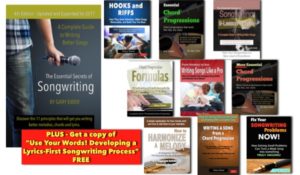There is a kind of musical “muscle memory,” where we keep relying on the same musical ideas as we write our songs. Practically every songwriter is familiar with it: similar sounding melodies, the same (or almost the same) chord progressions, the same kinds of lyrics, and so on.
A bit of similarity between songs you write shouldn’t surprise you, or even necessarily worry you. Every songwriter has a style that is usually recognizable, and as long as it’s not overly similar, it’s usually OK. Beethoven sounds like Beethoven, after all, so he was also guilty of choosing similar-sounding musical ideas, at least to a point.
 If you like creating melodies, but find that it’s hard to add chords to it, you need to read “How to Harmonize a Melody.” This eBook comes complete with sound samples and step-by-step guides to help you.
If you like creating melodies, but find that it’s hard to add chords to it, you need to read “How to Harmonize a Melody.” This eBook comes complete with sound samples and step-by-step guides to help you.
Chord progressions are particularly susceptible to locking us into a songwriting style that sounds the same from song to song. If you find that your fingers are always moving to D-A-Bm-G, or D-G-A7-D, or something similar, you’ll find that your melodies will also start to have a worrying sameness about them.
The obvious solution is to find other chord progressions, but it’s not always so easy to do this. Not that other progressions are hard to find; it’s more that the mood of a song is strongly dictated by the chords you use, and so it’s hard to simply take another progression if it’s not giving you the mood you want.
So always choosing the same — or very similar — chord progressions exposes a very real problem, which is that it’s quite likely that your songs are exhibiting melodies, lyrics and possibly even song topics that are similar from one song to the next.
The easiest solution to this is to dig into books of chord progressions, look for ones that exhibit the kind of mood you want, and then either use them or modify them to suit your song.
Identifying the kind of mood you want for your song is your first task. If you find yourself always choosing D-A-Bm-G, there’s a reason for that: it starts with a bright, hopeful sound (D-A), then moves to something a bit more melancholic, more introspective (Bm-G). So you’ve chosen a progression that’s a kind of universal one, and that’s why it’s so popular.
If your song lyric indicates a mood that is universal — a bit happy, a bit sad — you’ve got options, as long as you mix major with minor the way D-A-Bm-G does:
- D Em G A (I ii IV V)
- D Bm C G (I vi bVII IV)
- D D/F# G Gm (I I6 IV iv)
- D C G/B G (I bVII IV6 IV)
- D F#m G G/B (I iii IV IV6)
As y0u play through these progressions, you become aware of which parts sound bright and which parts sound a bit darker.
Now notice what happens when you:
- Experiment with a faster or slower tempo.
- Experiment with busier or more relaxed accompanying rhythms.
- Experiment with higher or lower voicings.
- Experiment with thicker or thinner chords.
- Experiment with different time signatures.
So even with these 5 very similar progressions, you actually have a multitude of presentations that give you literally dozens of different sounds, different approaches and different uses.
Once you’ve got chords you like, you now need to experiment with melodic shapes and ranges. Try higher ones, lower ones, melodies that move from high to low and back again (“U-shaped”), or ones that move from low to high and back down (“inverted-U”).
But if these chords sound a bit too much like ones you’ve used in the past, find new ones. You can either create them yourself by being aware of the balance between major and minor and how that affects mood, or you can simply dive into your chord progression collections. (“The Essential Secrets of Songwriting” 10-eBook Bundle contains several chord progression eBooks you’ll find helpful.)
As you write, be mindful of the songs you’ve written recently, as you may have to actively work to have your new song melody sound different. Don’t follow the patterns you developed for your previous songs. Break out, try something new, be as unique as you can.
 Written by Gary Ewer. Follow on Twitter.
Written by Gary Ewer. Follow on Twitter.
“Fix Your Songwriting Problems – NOW!” shows you the most common songwriting mistakes that practically every songwriter has made at some point, with solutions you can apply to fix those problems. Get it separately, or as part of “The Essential Secrets of Songwriting” 10-eBook Bundle.











